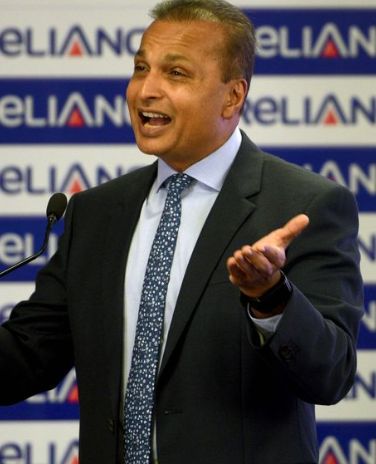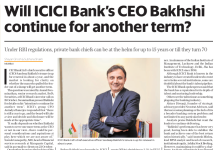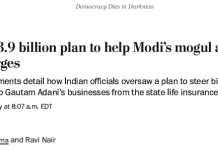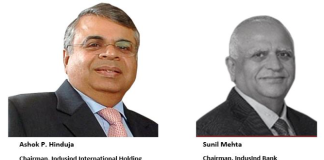By P R Sanjai and Anto Antony3 May 2019, 00:02 GMT+5:30
- Reliance Capital has seen downgrades by three rating agencies
- Asset sales are key to tide over repayments, cash squeeze

S
In this article
RCAPTRELIANCE CAPITAL136.75INR-0.30-0.22%MCOMOODY’S CORP192.77USD-1.13-0.58%RCOMRELIANCE COMMUNI1.95INR+0.05+2.63%RELHOMERELIANCE HOME FI25.30INR+0.10+0.40%RILRELIANCE INDS1,410.75INR+5.70+0.41%
The last stronghold in embattled tycoon Anil Ambani’s phone carrier-to-power empire is also developing fault lines.
Reliance Capital Ltd., his financial services business that almost doubled its profit in five years, had largely remained insulated from the distress plaguing the wider conglomerate. Now, the company that controls India’s fifth-biggest mutual fund, is racing to close a planned $2 billion of asset sales to bolster its finances after cash dwindled to 110 million rupees ($1.6 million) as of March, according to CARE Ratings.
With $252 million of debt falling due over May and June, a unit of Moody’s Investors Service and two other local firms have slashed ratings of Reliance Capital or its short-term instruments, citing holdups in asset sales, deteriorating liquidity and risks on loans to unprofitable affiliates. The downgrades came against the backdrop of soaring finance costs for an industry shaken by last year’s meltdown at one of the nation’s biggest shadow lenders that’s unrelated to Reliance Capital.U
Asset disposals are key to averting a crisis at Reliance Capital, said Mathew Antony, a managing partner at Mumbai-based Aditya Consulting, a credit advisory firm. “Unless some strategic infusion of long-term equity comes into the company, the day when Reliance Capital falls into a liquidity crisis isn’t too far,” he said.
Upcoming Repayments
A Reliance Capital spokesman declined to comment on upcoming repayments or the steps being taken to improve liquidity.
The company told exchanges on April 27 that it only has short-term debt of 9.5 billion rupees, which will get fully repaid by end-September using proceeds from the sale of its stake in the asset management business. The 43 percent stake was valued at 53 billion rupees, it said.
Despite 140 billion rupees of planned divestment, almost all the transactions are behind schedule, CARE Ratings said in an April 18 statement while slashing Reliance Capital’s long-term rating to A from A+ and putting it on a “credit watch.’’
Delayed Deals
| Asset | Expected Proceeds (in billion rupees) | Sale Timeline |
| Radio business | 17 | Announced in November 2016, delayed and expected by June 2019 |
| Reliance General Insurance’s IPO | 30 | Rescheduled from December 2018 to June 2019 |
| Reliance Nippon Life Asset Management | 70 | Selling 42.9 percent stake, was planned for May 2019 but likely by June |
| Prime Focus stake | undisclosed | Expected by May 2019 instead of April |
| Mahindra First Choice | undisclosed | Expected by June 2019 instead of April |
| Media properties | undisclosed | No indication |
Source: CARE Ratings
Brickwork Ratings pared it to A+ from AA last month while ICRA, Moody’s local unit, had downgraded the short-term ratings in March, saying the “timeliness of receipt of funds” from divestment “remains critical.” More cuts have followed for other group companies as well.
The conglomerate has struggled to sell assets in other firms. While Ambani managed to dispose of the Mumbai power distribution and road assets, many others, especially in telecommunications were scuttled due to regulatory hurdles or legal delays.
The strain at Reliance Capital heightens the challenges facing Ambani, 59, who’s seen his indebted telecom operator Reliance Communications Ltd.collapse into insolvency. His ventures in power, defense and infrastructure too have battled piling debt, bankruptcy cases and regulatory snags.
Anil Ambani carved out these newer businesses for himself from Reliance Industries Ltd. as part of a 2005 settlement with his older brother, Mukesh Ambani, following the death of their father Dhirubhai Ambani three years earlier.
Bailout by Sibling
The younger tycoon’s woes came to the fore in March when Mukesh stepped just in time to settle an overdue payment and save Anil the embarrassment of a stint in jail. The value of Anil’s holdings in companies has plunged to about $120 million from a net worth of at least $31 billion in 2008, according to data compiled by Bloomberg.

Read: Former Billionaire Races to Raise $80 Million and Avoid Jail
ICRA has also red-flagged Reliance Capital’s “substantial exposure toward” group companies which can curb its ability to raise and repay its near-term debt obligations.
| Pain PointsReliance Capital has invested and lent a total 137.48 billion rupees to other Anil Ambani group companies, including loss-making ones in telecom, media and entertainmentConsolidated net worth tumbled to 81.4 billion rupees by Dec. 31, less than half the level at the end of March 2018The financier had achieved only about a third of the total deals that were originally scheduled to wrap up by September 2018Three-quarters of controlling shareholder’s stake is pledgedSource: ICRA, CARE |
Reliance Mutual Fund wrote down about $233 million of investments in Reliance Home Finance Ltd. and Reliance Commercial Finance Ltd. last month, although it said investors’ interests will be protected.
Shares of Reliance Capital have plummeted 40 percent this year, triggered partly by adverse news flow around Ambani’s companies and partly the shock default of shadow financier Infrastructure Leasing and Financial Services Ltd., which squeezed funding for all non-bank lenders.
Read Andy Mukherjee’s column: India’s Shadow-Bank Bust Has a Lehman Echo
Reliance Communications is headed for bankruptcy proceedings after it failed to close the sale of its telecom assets and repay lenders. Reliance Naval and Engineering Ltd. has proven hard to turn around while Reliance Power Ltd. has been fighting for higher tariffs to make up for increased costs.
“When all group companies are constrained by liquidity problems, the strongest company will get impacted as a natural fallout,” said Hemindra Hazari, an independent analyst who writes for the Smartkarma platform. Reliance Capital is one of the four Anil Ambani group companies conglomerate that are among the worst performers on the S&P BSE500 index this year.

Profit Doubles
Reliance Capital, however, has seen its revenue and profits rise over the past few years. Net income nearly doubled to 13.1 billion rupees in the 12 months through March 2018 from five years ago, while net revenue tripled to 158.7 billion rupees.
Also despite the recent downgrades, it’s still several notches above the junk category. Quoting the methodology of CARE and Brickworks, the company said that its current rating implies “adequate degree of safety regarding timely servicing of financial obligations.”
But asset sales “in a time bound manner” are key for Reliance Capital to tide over its difficulties, according to Kranthi Bathini, an analyst at WealthMills Securities. “Though these assets are good, they may not manage to get the kind of valuations that they have been looking for,” said Bathini. “The bidders know the company is in dire straits.”
— With assistance by Ravil Shirodkar, Anurag Joshi, and Ameya KarveUP NEXT














